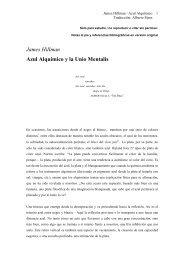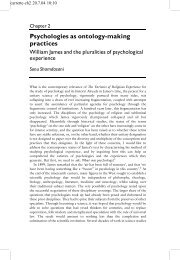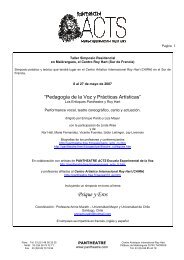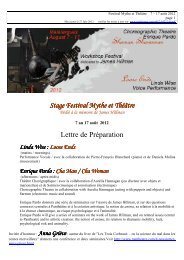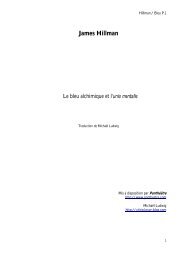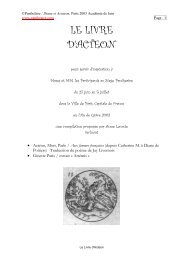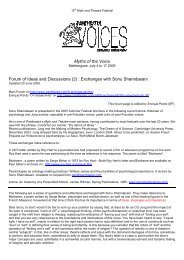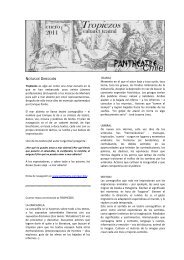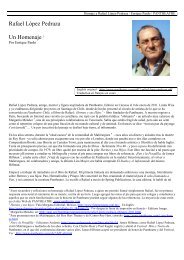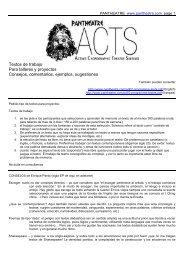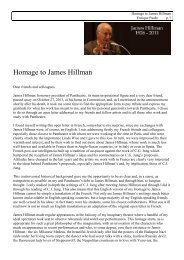James Hillman Alchemical Blue and the Unio Mentalis - Pantheatre
James Hillman Alchemical Blue and the Unio Mentalis - Pantheatre
James Hillman Alchemical Blue and the Unio Mentalis - Pantheatre
Create successful ePaper yourself
Turn your PDF publications into a flip-book with our unique Google optimized e-Paper software.
PANTHEATRE Reading List : <strong>James</strong> <strong>Hillman</strong> / <strong>Alchemical</strong> <strong>Blue</strong> p.1<br />
For study purposes only.<br />
<strong>James</strong> <strong>Hillman</strong><br />
<strong>Alchemical</strong> <strong>Blue</strong> <strong>and</strong> <strong>the</strong> <strong>Unio</strong> <strong>Mentalis</strong><br />
<strong>the</strong> soul<br />
vanishes<br />
<strong>the</strong> soul. vanishes, into <strong>the</strong><br />
shape of things<br />
—ROBERT KELLY, “The <strong>Blue</strong>”.<br />
A chapter from a long study “Silver <strong>and</strong> <strong>the</strong> White Earth,” <strong>the</strong> first part of which appeared in Spring 1980 <strong>and</strong> <strong>the</strong> second in Spring 1981: An Annual of<br />
Archetypal Psychology <strong>and</strong> Jungian Thought. A fur<strong>the</strong>r piece <strong>and</strong> relevant to this is “Salt: An Essay in <strong>Alchemical</strong> Psychology” in The Virgin in Myth, Literature<br />
<strong>and</strong> Society (Joanne Stroud <strong>and</strong> Gail Thomas, eds.), forthcoming, Spring Publications, Summer 1981. Abbreviations are: CW” : Collected Works of C. G.<br />
Jung, 20 volumes, Bollingen Series, Princeton University Press; Paracelsus: The Hermetic <strong>and</strong> <strong>Alchemical</strong> Writings of Paracelsus, 2 volumes, New Hyde Park:<br />
University Books, 1967; HM: The Hermetic Museum . . . containing Twenty-two most celebrated Chemical Tracts (1678), 2 volumes, London: Watkins, 1953.<br />
TRANSITIONS FROM BLACK TO WHITE sometimes go through a series of<br />
o<strong>the</strong>r colors, i notably darker blues, <strong>the</strong> blues of bruises, sobriety, puritan selfexamination;<br />
<strong>the</strong> blues of slow jazz ii . Silver’s color was not only white but also<br />
blue. Rul<strong>and</strong> lists 27 kinds of blue-colored silver. Norton writes (HM II:45): “Silver<br />
may easily be converted into <strong>the</strong> colour of <strong>the</strong> lazulite, because… silver,<br />
produced by air, has a tendency to become assimilated to <strong>the</strong> color of <strong>the</strong> sky.” iii<br />
So strong is <strong>the</strong> association of blue with silver <strong>and</strong> whitening, that even when<br />
modern chemistry disputes alchemical testimony (deriving a blue pigment from<br />
silver treated with salt, vinegar, etc.), it assumes <strong>the</strong> alchemists had some to-usunknown<br />
physical justification for <strong>the</strong>ir claim. iv Is not <strong>the</strong> claim based ra<strong>the</strong>r on<br />
fantasy, a sophic silver of a whitened imagination which knows that blue belongs<br />
to silvering, <strong>and</strong> <strong>the</strong>refore sees it?<br />
The blue transit between black <strong>and</strong> white is like that.-sadness which<br />
emerges from despair as it proceeds towards reflection. Reflection here comes<br />
from or takes one into a blue distance, less a concentrated act that we do than<br />
something insinuating itself upon us as a cold, isolating inhibition. This vertical
PANTHEATRE Reading List : <strong>James</strong> <strong>Hillman</strong> / <strong>Alchemical</strong> <strong>Blue</strong> p.2<br />
For study purposes only.<br />
withdrawal is also like an emptying out, <strong>the</strong> creation of a negative capability, or a<br />
profound listening — already an intimation of silver (Spr. ‘80, pp. 41-44, silver<br />
<strong>and</strong> sound).<br />
These very experiences Goe<strong>the</strong> associates with blue v :<br />
…blue still brings a principle of darkness with it... As a hue it is powerful,<br />
but it is on <strong>the</strong> negative side, <strong>and</strong> in its highest purity is, as it were, a<br />
stimulating negation. . . a kind of contradiction between excitement <strong>and</strong><br />
repose.<br />
As <strong>the</strong> upper sky <strong>and</strong> mountains appear blue, so a blue surface seems<br />
to recede from us.<br />
… it draws us after it.<br />
<strong>Blue</strong> gives us an impression of cold, <strong>and</strong> thus, again, reminds us of<br />
shade. We have before spoken of its affinity with black.<br />
Rooms which are hung with pure blue, appear in some degree larger, but<br />
at <strong>the</strong> same time empty <strong>and</strong> cold.<br />
…objects seen through a blue glass [are] gloomy <strong>and</strong> melancholy.<br />
Sadness is not <strong>the</strong> whole of it. A turbulent dissolution of <strong>the</strong> nigredo can also<br />
show as blue movies, blue language, l’amour bleu, blue-beard, blue murder, <strong>and</strong><br />
cyanotic body. When <strong>the</strong>se sorts of pornographic, perverse, ghastly, or vicious<br />
animus/anima fantasies start up, vi we can place <strong>the</strong>m within <strong>the</strong> blue transition<br />
toward <strong>the</strong> albedo. Then we will look for bits of silver in <strong>the</strong> violence. There are<br />
patterns of self-recognition forming by means of horror <strong>and</strong> obscenity. The soul’s<br />
putrefactio is generating a new anima consciousness, a new psychic grounding<br />
that must include underworld experiences of <strong>the</strong> anima itself: her deathly <strong>and</strong><br />
perverse affinities. The dark blue of <strong>the</strong> Madonna’s robe bears many shadows,<br />
<strong>and</strong> <strong>the</strong>se give her depths of underst<strong>and</strong>ing, just as <strong>the</strong> mind made on <strong>the</strong> moon<br />
has lived with Lilith so that its thought can never be naive, never cease to strike<br />
deep toward shadows. vii <strong>Blue</strong> protects white from innocence.<br />
The vertical direction, as Jung reaffirms (CJV 12, para.320), is traditionally<br />
associated with blue. viii Ancient Greek words for blue signified <strong>the</strong> sea. ix In<br />
Tertullian <strong>and</strong> Isadore of Seville, blue referred to both <strong>the</strong> sea <strong>and</strong> <strong>the</strong> sky, x<br />
much as <strong>the</strong> Greek word (bathun) <strong>and</strong> <strong>the</strong> Latin (altus) connoted high <strong>and</strong> deep<br />
by one word. The vertical dimension as hierarchy continues in our speech as<br />
blue blood for nobility, blue ribbons, <strong>and</strong> <strong>the</strong> many mythological images of ‘blue<br />
Gods’: Kneph in Egypt <strong>and</strong> Odin’s blue wrappings, xi Jupiter <strong>and</strong> Juno, xii Krishna<br />
<strong>and</strong> Vishnu, Christ in his earthly ministry like that blue Christ-man seen by<br />
Hildegard of Binge. xiii<br />
The transit from black to white via blue xiv implies that blue always brings black<br />
with it. (Among African peoples, for instance, black includes blue; xv whereas in<br />
<strong>the</strong> Jewish-Christian tradition blue belongs ra<strong>the</strong>r than white). xvi <strong>Blue</strong> bears<br />
traces of <strong>the</strong> mortificatio into <strong>the</strong> whitening. What before was <strong>the</strong> stickiness of <strong>the</strong><br />
black, like pitch or tar, unable to be rid of, turns into <strong>the</strong> traditionally blue virtues<br />
of constancy <strong>and</strong> fidelity. The same dark events feel different. The tortured <strong>and</strong><br />
symptomatic aspect of mortification—flaying oneself, pulverizing old structures,<br />
decapitation of <strong>the</strong> headstrong will, <strong>the</strong> rat <strong>and</strong> rot in one’s personal cellar—give<br />
way to depression. As even <strong>the</strong> darkest blue is not black, so even <strong>the</strong> deepest<br />
depression is not <strong>the</strong> mortificatio which means death of soul. The mortificatio is<br />
more driven, images locked compulsively in behavior, visibility zero, psyche<br />
trapped in <strong>the</strong> inertia <strong>and</strong> extension of matter. A mortificatio is a time of<br />
symptoms. These inexplicable, utterly materialized tortures of psyche in physis
PANTHEATRE Reading List : <strong>James</strong> <strong>Hillman</strong> / <strong>Alchemical</strong> <strong>Blue</strong> p.3<br />
For study purposes only.<br />
are relieved, according to <strong>the</strong> procession of colors, by a movement toward<br />
depression, which can commence as a mournful regret even over <strong>the</strong> lost<br />
symptom: “It was better when it hurt physically—now I only cry.” <strong>Blue</strong> misery. So,<br />
with <strong>the</strong> appearance of blue, feeling becomes more paramount <strong>and</strong> <strong>the</strong> paramount<br />
feeling is <strong>the</strong> mournful plaint (Rimbaud xvii equates blue with vowel “0”;<br />
K<strong>and</strong>insky xviii with <strong>the</strong> sounds of <strong>the</strong> flute, cello, double bass <strong>and</strong> organ). These<br />
laments hint of soul, of reflecting <strong>and</strong> distancing by imaginational expression.<br />
Here we can see more why archetypal psychology has stressed depression as<br />
<strong>the</strong> via regia in soulmaking. xix The ascetic exercises that we call “symptoms”<br />
(<strong>and</strong> <strong>the</strong>ir “treatments”), <strong>the</strong> guilty despairs <strong>and</strong> remorse as <strong>the</strong> nigredo decays,<br />
reduce <strong>the</strong> old ego-personality, but this necessary reduction is only preparatory<br />
to <strong>the</strong> sense of soul which appears first in <strong>the</strong> blued imagination of depression.<br />
Let us say, blue is produced by a collaboration between Saturn <strong>and</strong> Venus.<br />
According to Giacento Gimma, xx an eighteenth-century gemmologist, blue<br />
represents Venus, while <strong>the</strong> Goat, <strong>the</strong> Saturnian emblem of Capricorn, is blue’s<br />
animal. Capricorn, you will recall, extends slowly from <strong>the</strong> depths to <strong>the</strong> heights;<br />
immense range <strong>and</strong> immense patience. Where blue brings to Venus a deeper<br />
melancholy, <strong>and</strong> to Saturn a magnanimity (ano<strong>the</strong>r virtue of blue according to<br />
Gemma), it also slows <strong>the</strong> motion of whiteness, for it is <strong>the</strong> color of repose<br />
(K<strong>and</strong>insky). Thus blue is <strong>the</strong> retarding factor in <strong>the</strong> whitening. It is <strong>the</strong> element<br />
of depression, that raises deep doubts <strong>and</strong> high principles, wanting to settle<br />
things fundamentally <strong>and</strong> get <strong>the</strong>m right in order to clarify <strong>the</strong>m. This effect of<br />
blue on white can appear as feelings of service, labor, <strong>and</strong> disciplined<br />
observance of <strong>the</strong> rules, civil conformities like <strong>the</strong> blue cross, blue collar <strong>and</strong> blue<br />
uniforms, which figures of <strong>the</strong>se feelings might carry. The effect can also appear<br />
in feelings of guilt <strong>and</strong> conscience.<br />
There is indeed a “moral aspect of <strong>the</strong> whitening” xxi — <strong>and</strong> I think this is precisely<br />
<strong>the</strong> effect of blue. The whitening implies nei<strong>the</strong>r a lessening of shadow nor<br />
awareness about it. Ra<strong>the</strong>r, it means to me more space to carry its heights <strong>and</strong><br />
depths, its full stature - The soul is whiter because <strong>the</strong> shadow is out of <strong>the</strong><br />
repressed <strong>and</strong> aired in detailed conscious ways, <strong>the</strong> way blues give shadowdepth<br />
<strong>and</strong> precision of body in oil paintings, <strong>the</strong> way one drop of bluing makes<br />
<strong>the</strong> laundry whiter. The specific shading depends on <strong>the</strong> white-black proportion:<br />
“If <strong>the</strong> black exceeds <strong>the</strong> white by one degree, it exhibits a sky-blue color.” xxii<br />
The more black, <strong>the</strong> darker <strong>the</strong> blue; but even those celestial aspirations that<br />
race like a blue streak into <strong>the</strong> wild-blue yonder carry a modicum of darkness, a<br />
drop of putrefaction, a saving grace of depression in <strong>the</strong>ir hope. In fact, <strong>the</strong><br />
saving grace of Mary’s light blue may lie just in that ‘one degree of blackness.’<br />
I have myself understood <strong>the</strong> Jungian notion of blue as “<strong>the</strong> thinking function” to<br />
refer to blue’s ancient association with <strong>the</strong> impersonal depths of sky <strong>and</strong> sea, <strong>the</strong><br />
wisdom of Sophia, moral philosophy <strong>and</strong> truth. Images painted blue, says <strong>the</strong><br />
pseudoDionysius, “show <strong>the</strong> hidden depth of <strong>the</strong>ir nature.” xxiii <strong>Blue</strong> is “darkness<br />
made visible.” xxiv This depth is a quality of mind, an invisible power that<br />
permeates all things, like air—<strong>and</strong> blue, said Alberti, in his great Renaissance<br />
work On Painting xxv is <strong>the</strong> color of <strong>the</strong> element of air. When <strong>the</strong> darker blues<br />
appear in analysis, I gird myself, expecting that we are now in for <strong>the</strong> highs <strong>and</strong><br />
deeps of animus <strong>and</strong> anima, or what Jungians sometimes call “<strong>the</strong> animus of <strong>the</strong><br />
anima.” (Did you know that a “blue-stocking” meant a learned lady, that “blueism”<br />
meant “<strong>the</strong> possession or affectation of learning in a woman,” <strong>and</strong> that just plain<br />
“blue” once meant “fond of literature”?) xxvi These deep blues are inflations with<br />
<strong>the</strong> impersonal, <strong>the</strong> hidden. They do not feel high, but come across ra<strong>the</strong>r as<br />
ponderous philosophical thought, judgments about right <strong>and</strong> wrong, <strong>and</strong> <strong>the</strong>
PANTHEATRE Reading List : <strong>James</strong> <strong>Hillman</strong> / <strong>Alchemical</strong> <strong>Blue</strong> p.4<br />
For study purposes only.<br />
place of truth in analysis. What seems, <strong>and</strong> even is, so deep, however, is<br />
actually far off <strong>and</strong> away from matters at h<strong>and</strong>. What we are talking about<br />
“seems to recede from us” <strong>and</strong> “draws us after it” (Goe<strong>the</strong>) in <strong>the</strong> seductive<br />
manner of <strong>the</strong> anima.<br />
By remembering that <strong>the</strong> animus of <strong>the</strong> anima is a psychic spirit attempting to<br />
enlighten <strong>the</strong> soul by deepening or raising it into impersonal truths, I am better<br />
able to get through <strong>the</strong>se analytical sessions. I realize, thanks to Goe<strong>the</strong>, that<br />
<strong>the</strong>se deep blue conversations of “stimulating negation” (negative animus<br />
thoughts, negative anima judgments) have soul-searching intentions. A work of<br />
distancing <strong>and</strong> detaching (Goe<strong>the</strong>) is going on, an attempt at reflection that is still<br />
stained with <strong>the</strong> nigredo because it burrows too deep, pushes too hard,<br />
neglecting <strong>the</strong> immediate surfaces from which silver catches its light,<br />
None<strong>the</strong>less, <strong>the</strong> “negatives” that so obsess reflection with dark intuitions <strong>and</strong><br />
depressive ruminations are enlarging psychic space by emptying out <strong>the</strong> room<br />
(Goe<strong>the</strong>) of its former fixtures. As <strong>the</strong> soul tries to work its way out of darkness<br />
by means of philosophical effort, <strong>the</strong> whitening is taking place; <strong>the</strong> animus is in<br />
service of <strong>the</strong> anima. Even <strong>the</strong> negative mood <strong>and</strong> critique, my own withdrawal,<br />
that I feel during <strong>the</strong>se exercises belong also to this blue way toward whitening.<br />
The nigredo ends nei<strong>the</strong>r with a bang nor a whimper, but passes imperceptibly<br />
into breath-soul (anima) with a sigh. It helps to remember an image from Rabbi<br />
ben Jochai told by Scholem. xxvii The ascending flame is white, but right below as<br />
its very throne is a blue-black light whose nature is destructive. The blue-black<br />
flame draws stuff to it <strong>and</strong> consumes it as <strong>the</strong> whiteness flames steadily on. The<br />
destructive blue <strong>and</strong> <strong>the</strong> white belong in <strong>the</strong> same fire. As Scholem comments,<br />
by virtue of its very inhesion in <strong>the</strong> nigredo, <strong>the</strong> blue flame is able to consume <strong>the</strong><br />
darkness it feeds upon..<br />
The connotations that we have uncovered in this amplification indicate <strong>the</strong><br />
importance of blue in <strong>the</strong> alchemical process. Were <strong>the</strong> white to come merely as<br />
a clearing off, something essential would be missed. Something must<br />
incorporate into <strong>the</strong> albedo a resonance of, a fidelity to, what has happened <strong>and</strong><br />
transmit <strong>the</strong> suffering with ano<strong>the</strong>r shading: not as grinding pain, decay, <strong>and</strong> <strong>the</strong><br />
memory of depression, but as value. Value, we recall, (Spr. ‘80, pp. 35-37)<br />
belongs to <strong>the</strong> phenomenology of silver. The sense of <strong>the</strong> value of psychic<br />
realities is not born merely from relief of black distress. The blue qualifies <strong>the</strong><br />
white with worth in <strong>the</strong> ways we have mentioned <strong>and</strong> especially by its<br />
introduction of moral, intellectual <strong>and</strong> divine concerns, <strong>the</strong>reby bringing to <strong>the</strong><br />
whitened mind a capacity for evaluating images, devotion to <strong>the</strong>m, <strong>and</strong> a sense<br />
of <strong>the</strong>ir truth, ra<strong>the</strong>r than only reflection upon <strong>the</strong>ir play as fantasies. It is <strong>the</strong> blue<br />
which deepens <strong>the</strong> idea of reflection beyond <strong>the</strong> single notion of mirroring, to <strong>the</strong><br />
fur<strong>the</strong>r notions of pondering, considering, meditating.<br />
The colors which herald white are spoken of as Iris <strong>and</strong> <strong>the</strong> rainbow, as<br />
many flowers, <strong>and</strong> mainly as <strong>the</strong> brilliance of <strong>the</strong> peacock’s tail with its multiple<br />
eyes. xxviii According to Paracelsus, xxix <strong>the</strong> colors result from dryness acting on<br />
moisture. Believe it or not, <strong>the</strong>re is more color in <strong>the</strong> alchemical desert than in<br />
<strong>the</strong> flood, in less emotion than in more. Drying releases <strong>the</strong> soul from personal<br />
subjectivism, <strong>and</strong> as <strong>the</strong> moisture recedes that vivacity once possessed by<br />
feeling can now pass over into imagination. <strong>Blue</strong> is singularly important here<br />
because it is <strong>the</strong> color of imagination tout court. I base this apodicticus not only<br />
on all we have been exploring: <strong>the</strong> blue mood which sponsors reverie, <strong>the</strong> blue<br />
sky which calls <strong>the</strong> mythic imagination to its far<strong>the</strong>st reaches, <strong>the</strong> blue of Mary<br />
who is <strong>the</strong> Western epitome of anima <strong>and</strong> her instigation of image-making, <strong>the</strong><br />
blue rose of romance, a pathos which pines for <strong>the</strong> impossible contra naturam<br />
(<strong>and</strong> pathos, <strong>the</strong> flower, was a blue larkspur or delphinium placed on graves); I<br />
call also on Wallace Stevens’ blue <strong>and</strong> Cezanne’s blue as testimonies.<br />
<strong>Blue</strong> “represents in [Stevens’] work <strong>the</strong> imagination . . . such as <strong>the</strong> romantic or<br />
<strong>the</strong> imaginative in contradistinction to <strong>the</strong> realistic.” xxx And it was as well for
PANTHEATRE Reading List : <strong>James</strong> <strong>Hillman</strong> / <strong>Alchemical</strong> <strong>Blue</strong> p.5<br />
For study purposes only.<br />
Stevens <strong>the</strong> color of intellectual stability <strong>and</strong> “reason.” “Both <strong>the</strong> intellect <strong>and</strong><br />
imagination are blue,” xxxi just as Stevens’ poetry presents that combination of<br />
thought <strong>and</strong> image so successfully. xxxii The appearance of blue in <strong>the</strong> coloration<br />
process indicates that span of <strong>the</strong> spectrum where thought <strong>and</strong> image begin to<br />
coalesce, images provide <strong>the</strong> medium for thoughts while reflections take an<br />
imaginative turn away from <strong>the</strong> dark <strong>and</strong> confined frustration of <strong>the</strong> nigredo <strong>and</strong><br />
toward <strong>the</strong> wider horizon of mind. The blue instrument moves soul from sounding<br />
its small lament to <strong>the</strong> great breath of K<strong>and</strong>insky’s organ, its largo, <strong>the</strong> spacious<br />
march of philosophizing that can incorporate <strong>the</strong> hurts of one’s history into a<br />
tragic sense of life.<br />
As with Stevens, so with Cezanne, xxxiii “When he was composing… only a<br />
visionary’s or a poet’s imaginative conception… could be of help to him. It was<br />
impossible for him to start out from an isolated real thing seen.” xxxiv He based his<br />
painting on “shadow paths <strong>and</strong> contours” xxxv out of which ‘real things’ emerged as<br />
local high points. The imaginative conception, <strong>the</strong> visionary shadow, originates<br />
<strong>and</strong> supports <strong>the</strong> real thing seen in nature. “The deepest shadow colour in<br />
Cezanne’s paintings, <strong>the</strong> one which supports <strong>the</strong> composition <strong>and</strong> is most<br />
appropriate for shadows, is blue.” xxxvi “Cezanne gave blue a new depth of<br />
meaning... by making it <strong>the</strong> foundation of his world of objects ‘existing toge<strong>the</strong>r.’<br />
For, when he used blue in this way, he transcended any special connotation<br />
which had attached to its former uses. <strong>Blue</strong> was now recognized as belonging to<br />
a deeper level of existence. It expressed <strong>the</strong> essence of things <strong>and</strong> <strong>the</strong>ir abiding,<br />
inherent permanence <strong>and</strong> placed <strong>the</strong>m in a position of unattainable<br />
remoteness.” xxxvii<br />
The blue foundation is <strong>the</strong> imaginal ground which allows <strong>the</strong> eye to see<br />
imaginatively, <strong>the</strong> event as image, creating at <strong>the</strong> same time a remoteness from<br />
real things (Cezanne), from <strong>the</strong> green of <strong>the</strong> actual world (Stevens), a<br />
remoteness felt in <strong>the</strong> nostalgia which blue brings. With blue comes both <strong>the</strong><br />
longing toward white <strong>and</strong> a sad acknowledgement that as whitening proceeds<br />
one both comes home <strong>and</strong> can’t go home again.<br />
Once <strong>the</strong> black turns blue, darkness can be penetrated (unlike <strong>the</strong> nigredo which<br />
absorbs all insights back into itself, compounding <strong>the</strong> darkness with negative<br />
introspections). The shift to blue allows air so that <strong>the</strong> nigredo can meditate itself,<br />
imagine itself, recognize that this very shadow state expresses “<strong>the</strong> essence of<br />
things <strong>and</strong> <strong>the</strong>ir abiding, inherent permanence.” Here is imaginal consciousness<br />
affirming its ground.<br />
Cezanne wrote: “<strong>Blue</strong> gives o<strong>the</strong>r colours <strong>the</strong>ir vibration, so one must bring a<br />
certain amount of blue into a painting.” xxxviii From his perspective, blue would be<br />
<strong>the</strong> crucial color in <strong>the</strong> palette of <strong>the</strong> peacock because it transforms <strong>the</strong> o<strong>the</strong>r<br />
colors into possibilities of imagination, into psychological events, that come to life<br />
because of blue. Boehme writes, “Imagination of <strong>the</strong> great Mystery, where a<br />
wondrous essential Life is born” results from <strong>the</strong> colors. xxxix The full flowering of<br />
imagination shows itself as <strong>the</strong> qualitative spread of colors so that imagining is a<br />
coloring process, <strong>and</strong> if not in literal colors, <strong>the</strong>n as <strong>the</strong> qualitative differentiation<br />
of intensities <strong>and</strong> hues which is essential to <strong>the</strong> act of imagination.<br />
When <strong>the</strong> colors shine in <strong>the</strong> peacock’s tail so too do <strong>the</strong> eyes whereby <strong>the</strong>y can<br />
be seen. Imaginative vision precedes <strong>the</strong> whiteness itself, o<strong>the</strong>rwise <strong>the</strong> white<br />
earth cannot be perceived as <strong>the</strong> transfiguration of nature by imagination. For<br />
this new perception, <strong>the</strong> perception of colors too goes through transubstantiation<br />
into a mystical or painterly sense of <strong>the</strong>m as substances, as <strong>the</strong> complexions on<br />
<strong>the</strong> faces of light which reveal <strong>the</strong> true quality of nature, its endlessly subtle <strong>and</strong><br />
multiple intensities. Colors shift from being phenomena of light to phenomena<br />
<strong>the</strong>mselves; or, light shifts to being <strong>the</strong> presentation of color <strong>and</strong> secondary to it<br />
so that <strong>the</strong> white earth is not sheer white in <strong>the</strong> literal sense but a field of<br />
flowers, xl a peacock’s tail, a coat of many colors.<br />
The transubstantiation announced by <strong>the</strong> peacock reverses <strong>the</strong> history of
PANTHEATRE Reading List : <strong>James</strong> <strong>Hillman</strong> / <strong>Alchemical</strong> <strong>Blue</strong> p.6<br />
For study purposes only.<br />
philosophy. The color visions of Newton <strong>and</strong> Locke, of Berkeley <strong>and</strong> Hume<br />
belong to <strong>the</strong> subjectivism of <strong>the</strong> nigredo <strong>and</strong> <strong>the</strong> mortification of nature. Color<br />
can now become a primary quality again, <strong>the</strong> thing itself as phainoumenon on<br />
display, <strong>the</strong> heart in <strong>the</strong> matter, prior to such abstractions as bulk, number, figure<br />
<strong>and</strong> motion. When color is, <strong>the</strong> world is as we see it—not merely green as<br />
naturalistic sense-perception believes, but green because of its blue shadow. xli<br />
The world is as we see it in our dreams <strong>and</strong> poems, visions <strong>and</strong> paintings, a<br />
world that is truly a cosmos, cosmetically adorned, an aes<strong>the</strong>tic event for <strong>the</strong><br />
senses because <strong>the</strong>y have become instruments of imagining.<br />
The multi flores, <strong>the</strong> myriad eyes in <strong>the</strong> tail, suggest that <strong>the</strong> colored vision is<br />
multiple vision. One must be able to see polychromatically, polymorphously,<br />
poly<strong>the</strong>istically before <strong>the</strong> terra alba appears. The movement from a monocentric<br />
universe to a cosmos of complex perspectives begins with blue since it “gives<br />
<strong>the</strong> o<strong>the</strong>r colours,” as Cezanne says, “<strong>the</strong>ir vibration.” Then <strong>the</strong> alchemical colors<br />
vanish <strong>and</strong> are replaced by a brilliant white lustre. Here one might be so dazzled<br />
by <strong>the</strong> new brilliance of mind as to take white literally, as if white meant only <strong>and</strong><br />
literally one thing — whiteness — <strong>the</strong>reby forgetting <strong>the</strong> multiplicity which made<br />
<strong>the</strong> whiteness possible xlii The multiplicity must already have been built into <strong>the</strong><br />
mind as <strong>the</strong> vibrations, shadings <strong>and</strong> subtleties that are not only <strong>the</strong>re in things<br />
but are <strong>the</strong>re in <strong>the</strong> eyes of <strong>the</strong> mind by which things are seen as images. It is as<br />
if we enter <strong>the</strong> world without preconceptions, startled by <strong>the</strong> phenomena where<br />
everything is given <strong>and</strong> nothing taken for granted.<br />
To experience in this manner is to recover innocence — hence <strong>the</strong> brilliant<br />
white lustre. Ruskin called it “<strong>the</strong> innocence of <strong>the</strong> eye,” “a sort of childish<br />
perception of <strong>the</strong>se flat stains of colour, merely as such, without consciousness<br />
of what <strong>the</strong>y signify.” xliii Attention shifts from <strong>the</strong> signification of perception to<br />
perception itself. We ask about qualities — What is <strong>the</strong>re? in what way is it<br />
<strong>the</strong>re? what is it doing <strong>the</strong>re? (ra<strong>the</strong>r than how did it get <strong>the</strong>re, why, <strong>and</strong> what<br />
good is it?)<br />
This excursion, <strong>the</strong>se images, <strong>and</strong> <strong>the</strong> figures whom we have summoned —<br />
Cezanne, Stevens, Rilke, Zola, K<strong>and</strong>insky, Jung, Picasso, Marc—reveal to us<br />
something of <strong>the</strong> nature of <strong>the</strong> unio mentalis. Jung, exp<strong>and</strong>ing on Dorn,<br />
considers <strong>the</strong> unio mentalis to be <strong>the</strong> union of spirit <strong>and</strong> soul (logos <strong>and</strong> psyche),<br />
i.e., freeing soul from body, its integration with spirit, prior to fur<strong>the</strong>r union with<br />
body (physis, physics, world, unus mundus). As a union of logos <strong>and</strong> psyche, <strong>the</strong><br />
unio mentalis is psychology, <strong>the</strong> achievement of a psychological spirit - I am<br />
underst<strong>and</strong>ing <strong>the</strong> unio mentalis also as <strong>the</strong> albedo goal of <strong>the</strong> work, <strong>the</strong><br />
activation of silver.<br />
The nature of this achievement can be garnered from <strong>the</strong> accounts of those<br />
we have summoned. They suggest that <strong>the</strong> alchemical unio mentalis is <strong>the</strong><br />
interpenetration of thought <strong>and</strong> image, xliv of perceived world <strong>and</strong> imaginal world,<br />
a state of mind no longer concerned with distinctions between things <strong>and</strong><br />
thought, appearance <strong>and</strong> reality, or between <strong>the</strong> spirit that develops <strong>the</strong>ory <strong>and</strong><br />
<strong>the</strong> soul that builds fantasy. We have colored this unio mentalis ‘blue,’ because<br />
<strong>the</strong> blue we have been encountering transfigures appearances into imaginal<br />
realities <strong>and</strong> imagines thought itself in a new way. <strong>Blue</strong> is preparatory to <strong>and</strong><br />
incorporated in <strong>the</strong> white, indicating that <strong>the</strong> white becomes earth, that is, fixed<br />
<strong>and</strong> real, when <strong>the</strong> eye becomes blue, that is, able to see through thoughts as<br />
imaginative forms <strong>and</strong> images as <strong>the</strong> ground of reality.<br />
Alchemy expresses this condition as <strong>the</strong> caelum or “blue tincture” (CW 14,<br />
para.703) which is a heavenly firmament, <strong>the</strong> celestial substance that is <strong>the</strong> color<br />
of “ciel” (p. 478, n77) or “color of air” (paras .691-92), a quintessencia that is<br />
curiously concocted, according to Dorn, from an underworld experience (703)<br />
that is also called “wine” (681-83). We cannot now go into <strong>the</strong> psychological<br />
importance of wine nor its vernacular relationship with blue drunkenness, blue<br />
noses, <strong>and</strong> blue laws. We can, however, remember Heraclitus’ saying that
PANTHEATRE Reading List : <strong>James</strong> <strong>Hillman</strong> / <strong>Alchemical</strong> <strong>Blue</strong> p.7<br />
For study purposes only.<br />
Dionysos <strong>and</strong> Hades are one, so that <strong>the</strong> mystery of <strong>the</strong> unio mentalis has an<br />
echo of a Dionysian mystery. Of <strong>the</strong> consciousness brought by this mystery we<br />
know what Dodds, Otto, <strong>and</strong> Kerényi have told us—nature comes alive; <strong>the</strong><br />
God’s presence permeates communal existence as a somber shadow that gives<br />
a joyous vibration to all things, or as Goe<strong>the</strong> described blue, “a kind of contradiction<br />
between excitement <strong>and</strong> repose.” The unio mentalis implies a divine<br />
drunkenness xlv that does not exclude what <strong>the</strong> normal nigredo mind considers<br />
pathological. I cannot call Dionysos directly ‘blue’ despite <strong>the</strong> fact that his hair<br />
<strong>and</strong> eyes, in <strong>the</strong> Homeric Hymn (7.5, 15) to him, are kyaneos. He sees with <strong>the</strong><br />
blue eye <strong>and</strong> to see him our eye must be colored in <strong>the</strong> same way. I can,<br />
however, connect this Lord of Souls <strong>and</strong> Wine with Kessler’s summary above of<br />
Cezanne’s blue: that “depth of meaning,” that “deeper level of existence” which<br />
both holds <strong>the</strong> world communally as “existing toge<strong>the</strong>r” <strong>and</strong> yet “in a position of<br />
unattainable remoteness.”<br />
When myths say Gods have blue hair or blue bodies, <strong>the</strong>y have. The Gods<br />
live in a blue place of metaphor, <strong>and</strong> <strong>the</strong>y are described less with naturalistic<br />
language than with poetic ‘distortion.’ Mythical talk must be full of hyperbole; <strong>the</strong><br />
Gods live in <strong>the</strong> highs <strong>and</strong> deeps. To depict <strong>the</strong>m rightly we need <strong>the</strong><br />
expressionist’s palette, not <strong>the</strong> impressionist’s, Precisely this shift into mythical<br />
perception occurs with <strong>the</strong> unio mentalis: we now imagine <strong>the</strong> nature of reality,<br />
<strong>and</strong> dark-blue becomes <strong>the</strong> right color to express Dionysos’ hair, because it is<br />
<strong>the</strong> natural, reasonable hue for <strong>the</strong> hair of this God in this Hymn, a most realistic<br />
depiction.<br />
Although <strong>the</strong> caelum here, as unio mentalis <strong>and</strong> quintessence, is a late<br />
stage, it is sometimes (Paracelsus, Figulus) said to be <strong>the</strong> prerequisite for all<br />
alchemical operations whatsoever. The mind from <strong>the</strong> beginning must be based<br />
in <strong>the</strong> blue firmament, like <strong>the</strong> lazuli stone <strong>and</strong> sapphire throne of mysticism, <strong>the</strong><br />
azure heaven of Boehme, philosophia. The blue firmament is an image of<br />
cosmological reason; it is a mythical place that gives metaphorical support to<br />
metaphysical thinking. It is <strong>the</strong> presentation of metaphysics in image form. xlvi<br />
These upper vaults of stone confirm <strong>the</strong> solidity of invisible thought in a mythical<br />
manner <strong>and</strong> <strong>the</strong>y show <strong>the</strong> mythical foundations of thought; <strong>the</strong>y allow, even<br />
comm<strong>and</strong>, a philosophy that reaches to just such cosmological heights <strong>and</strong><br />
depths, <strong>the</strong> full extension <strong>and</strong> glory of imagination as philosophy, philosophy as<br />
imagination, in <strong>the</strong> terra alba of <strong>the</strong> imaginal as described by Corbin.<br />
If <strong>the</strong> caelum must be present to begin with, <strong>the</strong>n to do alchemy one must be<br />
confirmed in imaginal durabilities, transcending mere psychological perspectives<br />
<strong>and</strong> metaphorical implications. The metaphorical twist that <strong>the</strong> adjective blue<br />
gives in <strong>the</strong> immense variety of its uses in vernacular speech, removing ordinary<br />
things from <strong>the</strong>ir ordinary sense, is only <strong>the</strong> beginning of <strong>the</strong> epistrophic return of<br />
all things to <strong>the</strong>ir imaginal ground. The mind itself must be drenched in blue,<br />
cosmological.<br />
Alchemy begins before we enter <strong>the</strong> mine, <strong>the</strong> forge, or laboratory. It begins<br />
in <strong>the</strong> blue vault, <strong>the</strong> seas, in <strong>the</strong> mind’s thinking in images, imagining<br />
ideationally, speculatively, silveredly, in words that are both images <strong>and</strong> ideas, in<br />
words that turn things into flashing ideas <strong>and</strong> ideas into little things that crawl,<br />
<strong>the</strong> blue power of <strong>the</strong> word itself, which locates this consciousness in <strong>the</strong> throat<br />
of <strong>the</strong> visuddha cakra (Spr. ‘80, p. 420 whose dominant color is a smoky-purpleblue.<br />
The caelum, <strong>the</strong>n, is a condition of mind. Envision it as a night-sky filled with<br />
<strong>the</strong> airy bodies of <strong>the</strong> Gods, those astrological constellations which are at once<br />
beasts <strong>and</strong> geometry <strong>and</strong> which participate in all things of <strong>the</strong> world as <strong>the</strong>ir<br />
imaginal ground. The caelum does not of course take place in your head, in your<br />
mind, but your mind moves in <strong>the</strong> caelum, touches <strong>the</strong> constellations, <strong>the</strong> thick<br />
<strong>and</strong> hairy skull opens to let in more light, <strong>the</strong>ir light, making possible a new idea<br />
of order, a cosmological imagination whose thought accounts for <strong>the</strong> cosmos in
PANTHEATRE Reading List : <strong>James</strong> <strong>Hillman</strong> / <strong>Alchemical</strong> <strong>Blue</strong> p.8<br />
For study purposes only.<br />
<strong>the</strong> forms of images.<br />
That we have had to go to figures like Stevens <strong>and</strong> Cezanne for more<br />
underst<strong>and</strong>ing of <strong>the</strong> coloring process tells us not only about <strong>the</strong> psychology of<br />
<strong>the</strong> unio mentalis; we are told also who are <strong>the</strong> alchemists in our time. The poets<br />
<strong>and</strong> painters, <strong>and</strong> <strong>the</strong> figures in us who are poets <strong>and</strong> painters, are those<br />
struggling with <strong>the</strong> continuing alchemical problem: <strong>the</strong> transubstantiation of <strong>the</strong><br />
material perspective into soul through ars, Artifex now artisan. The alchemical<br />
laboratory is in <strong>the</strong>ir work with words xlvii <strong>and</strong> paints, <strong>and</strong> psychology continues its<br />
tradition of learning from alchemy by learning from <strong>the</strong>m. xlviii They tell us one<br />
fur<strong>the</strong>r thing about <strong>the</strong> white earth: if <strong>the</strong> imaginal ground is first perceived by<br />
artistic method, <strong>the</strong>n <strong>the</strong> very nature of this earth must be aes<strong>the</strong>tic—<strong>the</strong> way is<br />
<strong>the</strong> goal. We come to <strong>the</strong> white ground when our way of doing psychology is<br />
aes<strong>the</strong>tic. An aes<strong>the</strong>tic psychology, a psychology whose muse is anima is<br />
already hesitantly moving, surely moving, in that white place.<br />
<strong>Blue</strong> Notes<br />
i Cf. Norton’s Ordinal (HM 11:38— 39). “Physicians have discovered nineteen colours<br />
intermediate between white <strong>and</strong> black in urine.... Magnesia (a term for white] throws out<br />
a mild, pure splendour in <strong>the</strong> subtle stage of our Art; <strong>and</strong> here we behold all colours that<br />
ever were seen by <strong>the</strong> mortal eye — a hundred colours, <strong>and</strong> certainly a good many more<br />
than have been observed in urine; <strong>and</strong> in all those colours our Stone must be found in all<br />
its successive stages. In <strong>the</strong> ordering of your practical experiments. <strong>and</strong> in conceiving <strong>the</strong><br />
different parts of <strong>the</strong> work in your own mind, you must have as many phases, or stages,<br />
as <strong>the</strong>re are colours.”<br />
ii For a rich, curious phenomenology of blue, see William Gaas, On Being <strong>Blue</strong>, Boston:<br />
Godine, 1976.<br />
iii The assimilation of silver (white) to <strong>the</strong> color of <strong>the</strong> sky compares with this paradox<br />
from Wittgenstein: “In a picture in which a piece of white paper gets its lightness ftom<br />
<strong>the</strong> blue sky, <strong>the</strong> sky is lighter than <strong>the</strong> white paper. And yet in ano<strong>the</strong>r sense blue is <strong>the</strong><br />
darker <strong>and</strong> white <strong>the</strong> lighter colour.” Remarks on Co/our, 1,2. University of California<br />
Press, 1978.<br />
iv Cf. Dorothy Wyckoff’s note to her edition of Albertus Magnus’ Book of Minerals,<br />
Oxford: Clarendon, 1967, pp. 192—93.<br />
v Goe<strong>the</strong>’s Co/or Theory, Rupprecht Mat<strong>the</strong>i <strong>and</strong> Herb Aach, eds., New York: van<br />
Nostr<strong>and</strong> Reinhold, 1971, p. 170 (p. 310 of <strong>the</strong> Eastlake translation).<br />
vi<br />
Cf. Gass for <strong>the</strong> weird <strong>and</strong> sexual blues, especially. On <strong>the</strong> cyanotic aspect of <strong>the</strong> blue,<br />
see Jung’s remarks on Picasso’s blue period (CW 15, para.210) which Jung compares<br />
with a Nekyia to <strong>the</strong> realm of Hades: ...we enter <strong>the</strong> underworld. The world of objects is<br />
death-struck, as <strong>the</strong> horrifying masterpiece of <strong>the</strong> syphilitic, tubercular, adolescent<br />
prostitute makes plain.”<br />
vii Cf. Jung, CW 12, para 322: “And how can man reach fulfillment if <strong>the</strong> Queen does not<br />
intercede for his black soul? She underst<strong>and</strong>s <strong>the</strong> darkness This passage follows<br />
Jung’s discussion of “blue.”<br />
viii Cf. J.E. Cirlot, A Dictionary of Symbols, London: Routledge, 1962, p. 52.<br />
ix Th. Thass-Thienemann, The Interpretation of language, New York: Aronson,<br />
x Dronke, p. 67. On <strong>the</strong> (light) blue sky, see Bachelard’s chapter “Le ciel bleu,” in his<br />
L’air et les songes, Paris: Corn, 1943. The underworld as an airy place, <strong>and</strong> blue, appears<br />
in <strong>the</strong> Navaho cosmology. The next to <strong>the</strong> deepest (red) world is blue, inhabited by blue<br />
birds. Gladys A. Reichard, Navaho Religion, Bollingen-Pan<strong>the</strong>on, 1950, 1:15.<br />
xi Harold Bayley, The Lost Language of Symbolism, London: Benn, 1912, I;78—79.<br />
Bayley derives ‘blue’ from words for ‘truth’—a curious example of archetypal fantasy<br />
displayed as etymology.<br />
xii Cirlot, p. 51.<br />
xiii Dronke, p. 98 (Scivias II, 2). Despite its ‘virtuousness’ blue was not a canonical color<br />
(Like violet, white, green, black). Does blue carry an indelible etymological taint?
PANTHEATRE Reading List : <strong>James</strong> <strong>Hillman</strong> / <strong>Alchemical</strong> <strong>Blue</strong> p.9<br />
For study purposes only.<br />
Kyanos cognate with Skr. cunya “empty, vacant, vain,” cuna-m “absence, want”; Latin,<br />
cavus “hollow” (p. 100). Caerulus (Lan. dark-blue sky) is cognate (via Skr. Cyama) with<br />
dark, vanish, leave, be left (p. 99), Livid (Lat. blue) belongs to a group of words meaning<br />
slipping away, shrinking, vanishing, flowing (p. 98). <strong>Blue</strong> (Germanic) itself belongs to “a<br />
large class of color-names... meaning... marked, rubbed, smeared,” stained <strong>and</strong> colored in<br />
<strong>the</strong> sense of ‘discolored’ (p. 73). Page numbers refer to Francis A. Wood, Color-Names<br />
<strong>and</strong> <strong>the</strong>ir Congeners (Halle: Niemeyer, 1902). Compare to <strong>the</strong>se etymologies of blue this<br />
digest of Goe<strong>the</strong>’s evaluation: “[blue] st<strong>and</strong>s on <strong>the</strong> negative side of <strong>the</strong> polarity of<br />
colours where deprivation, shadow, darkness, weakness, cold, distance, an attraction to<br />
<strong>and</strong> affinity with alkalis are to be found.” Kurt Badt, The Art of Cézanne, Univ.<br />
California Press, 1965, P. 59.<br />
xiv The black-white mixture in blue appears in an old British expression “blue skin” who<br />
was a “person begotten on a black woman by a white man.” One of <strong>the</strong> “blue squadron”<br />
meant “a lick of <strong>the</strong> tar brush.” Dictionary of Buckish Slang, University Wit <strong>and</strong><br />
Pickpocket Eloquence, London: C. Chappel, 1811.<br />
xv Dominique Zahan, “Colour Symbolism in Black Africa,” in Color Symbolism, op. cit.,<br />
p. 56.<br />
xvi The blue/white association is not only in Marian symbolism, since blue plays an<br />
especially spiritual role in Jewish mystical <strong>and</strong> cult symbolism, cf. Gershom Scholem,<br />
“Farben und ihre Symbolik in der Judischen Ueberlieferung und Mystik,” Eranos<br />
xvii Rimbaud’s sonnet “Voyelles” where blue equals ‘0,’ Omega.<br />
xviii Will Grohmann, Wassily K<strong>and</strong>insky, N.Y.: Harry Abrams, nd.p.89.<br />
xix “The blue-clo<strong>the</strong>d” is a current Persian way of naming Sufis for which “various<br />
explanations have been given.” (H. Corbin, The Man of Light in Iranian Sufism, Boulder:<br />
Shanibala, 1978, p. 157, n121). Supposedly, blue dress is “appropriate to those who are<br />
still in <strong>the</strong> first stages of <strong>the</strong> mystic life.” Dark blue clothing is worn when “<strong>the</strong> lower<br />
psyche (nigredo] has been overcome, as though one were in mourning for it.”<br />
xx G.F. Kunz, The Curious Lore of Precious Stones, Philadelphia: Lippincott, 1913, p.31,<br />
quoted from Della storia naturale delle Gemme, Napoli. 1730, 1;131—37. A century<br />
earlier (1611) Cesare Ripa lists in his painter’s dictionary (lconologia) <strong>the</strong>se figures who<br />
should be robed in blue: Astrology, Goodness, Poetry. Steadfastness <strong>and</strong> also<br />
Inconstancy (Picasso’s blue prostitute?, or at least <strong>the</strong> shadow side of <strong>the</strong> fidelity. truthconstancy<br />
construct.)<br />
xxi<br />
xxii<br />
xxiii<br />
M.-L. von Franz, Aurora Consurgens, Princeton Univ. Press, 1966, 243.<br />
Dronkc, p. 76.<br />
Dronke, p. 66.<br />
xxiv Cirlot, p. 51.<br />
xxv Leon Battista Alberti, On Painting, Yale Univ. paperbound, 1966, p. 50. To an earlier<br />
mind, <strong>the</strong> ‘airiness’ of blue could be physically demonstrated by <strong>the</strong> fact that blue paint<br />
is a most fugitive color, fading fast because it had no native pigment, only unwieldy<br />
crushed lapis lazuli brought from <strong>the</strong> Oxus region of Central Asia. On <strong>the</strong> history <strong>and</strong><br />
technology of blue paint, see Badt, op. cit., pp. 62, 79.<br />
xxvi<br />
These references can be found in T.L.O. Davies, A Supplementary English<br />
Diccionary, London: Bell, 1881, pp. 68—69.<br />
xxvii<br />
xxviii<br />
Scholem, pp. 45—7.<br />
“Then take silver, well purged from all metals.. . <strong>the</strong>n seal up <strong>the</strong> oil of Lutta ... <strong>and</strong><br />
set it in a Balneo to putrefy until it show all colours, <strong>and</strong> at last come to be crystalline<br />
white.” “The Bosom Book of Sir George Ripley” in Collectanea Chemica, london:<br />
Stuart & Watkins, 1963, p. 137. Paracelsus, 1:83, “When <strong>the</strong> regimen of <strong>the</strong> fire is<br />
moderated, <strong>the</strong> matter is by degrees moved to blackness. Afterwards, when <strong>the</strong> dryness<br />
begins to act upon <strong>the</strong> humidity, various flowers of different colours simultaneously rise<br />
in <strong>the</strong> glass, just as <strong>the</strong>y appear in <strong>the</strong> tail of <strong>the</strong> peacock, <strong>and</strong> such as no one has ever<br />
seen before. ... Afterwards, those colours disappear, <strong>and</strong> <strong>the</strong> matter at length begins to
PANTHEATRE Reading List : <strong>James</strong> <strong>Hillman</strong> / <strong>Alchemical</strong> <strong>Blue</strong> p.10<br />
For study purposes only.<br />
grow white…” Cf. Jung, CW 14, paras. 388, 391—92, <strong>and</strong> passim in Index, Volume 20:<br />
“peacock,” cauda pavonis, etc.<br />
xxix ibid.<br />
xxx<br />
Edward Kessler, Images of Wallace Stevens, Rutgers Univ. Press, 1972, p. 198 (cited<br />
from Hi Simons).<br />
xxxi<br />
ibid., p.203;” ‘The Man with <strong>the</strong> <strong>Blue</strong> Guitar,’ Stevens’ most overt use of blue as<br />
symbol, is in <strong>the</strong> poet’s own words a work of ‘pure imagination.’ The color is perhaps<br />
best characterized as a symbol for speculative thought, or simply for <strong>the</strong> mind” (p.196).<br />
xxxii<br />
“The poet, in order to fulfill himself, must accomplish a poetry that satisfies both <strong>the</strong><br />
reason <strong>and</strong> <strong>the</strong> imagination.” Wallace Stevens, The Necessary Angel, N.Y.: Knopf-<br />
Vintage, 1951, p. 42.<br />
xxxiii “Cezanne is mentioned far more frequently in <strong>the</strong> critical prose of Stevens than is<br />
any o<strong>the</strong>r modern painter.” <strong>James</strong> Baird, The Dome <strong>and</strong> <strong>the</strong> Rock, Baltimore:Johns<br />
Hopkins, 1968, p. 84. See pp. 82—93 on <strong>the</strong>ir likeness; although Baird emphasizes <strong>the</strong>ir<br />
common concern with structure, I am stressing <strong>the</strong>ir common regard for blue <strong>and</strong> its<br />
implications for <strong>the</strong>ir imaginal view of <strong>the</strong>ir work.<br />
xxxiv Kurt Badt, The Art of Cezanne, Univ. California Press, 1965, P. 56.<br />
xxxv<br />
xxxvi<br />
ibid., Chapter “Shadow-paths <strong>and</strong> Contours.”<br />
ibid., p. 56. The blue of Cézanne drew particular comment from both Zola <strong>and</strong> Rilke<br />
— no mean imaginers <strong>the</strong>mselves. Badt. pp. 56— 58.<br />
xxxvii ibid, p. 82.<br />
xxxviii<br />
ibid., p. 57. Compare Kessler’s remark on Stevens’ blue as “that human faculty<br />
which attempts to unify <strong>the</strong> disparate colors in external nature.” The <strong>Blue</strong> Rider group in<br />
Germany is ano<strong>the</strong>r instance of a union of thinking <strong>and</strong> imagination. “… blue was both<br />
K<strong>and</strong>insky’s <strong>and</strong> Marc’s favorite color ...” “We thought up <strong>the</strong> name (Der Blaue Reiter)<br />
while sitting at a cafe table… Both of us were fond of blue things, Marc of blue horses,<br />
<strong>and</strong> I of blue riders.” (K<strong>and</strong>insky’s own account, 1930) in Grohmann, op. cit., p. 78. The<br />
mystical inwardness in <strong>the</strong> depiction of ‘nature,’ ‘<strong>the</strong> dislike for ‘green,’ <strong>and</strong> <strong>the</strong><br />
metaphysical reflection <strong>the</strong>y brought to imagining all accord with <strong>the</strong> ‘blue’ tradition.<br />
xxxix In <strong>the</strong> same passage of Boehme (Mysteriumpansophicum, quoted by Jung, CW’ 9 i,<br />
para. 580), we find that first <strong>the</strong>re comes a “bright-blue,” <strong>the</strong>n various o<strong>the</strong>r color<br />
analogies to it <strong>and</strong> <strong>the</strong>n “it is like blue in green, yet each still has its brightness, <strong>and</strong><br />
shines.” The problem of Stevens, blue vs. green, is also noted by Boehme, who can see<br />
<strong>the</strong>m as joined yet retaining <strong>the</strong>ir difference.<br />
xl<br />
The many flowers appear in Corbin’s white earth. He speaks of this “sacred botany”<br />
which gives whitened consciousness a sensuous reality <strong>and</strong> particular content (ra<strong>the</strong>r<br />
than a mere snow field or white light). The flowers are an appearance in our Western<br />
context of <strong>the</strong> anima as Flora, <strong>the</strong> flowering of <strong>the</strong> imagination as rooted living forms.<br />
Corbin says: “<strong>the</strong> flowers play <strong>the</strong> part of <strong>the</strong> materia prima for alchemical meditation.<br />
This means mentally reconstituting Paradise, keeping company with heavenly beings”<br />
(Spiritual Body <strong>and</strong> Celestial Earth, Princeton Univ. Press, 1977, pp. 31—32). Von<br />
Franz gives a variety of splendid passages on <strong>the</strong> many flowers (Aurora Consurgens, pp.<br />
391—95, referring to Jung), which she interprets as “components of our psychic totality,<br />
<strong>the</strong> self’ <strong>and</strong> “indicate a blossoming of psychic relationship” as “human relationships” (p.<br />
395). The reduction of <strong>the</strong> flowers to “our” passes by <strong>the</strong> very material she has<br />
assembled, where she states, “In Greek alchemy flowers <strong>and</strong> blossoms are an image for<br />
spirits or souls” (p. 392). It is “<strong>the</strong> heavenly beings”—<strong>the</strong> imaginal figures—with whom<br />
<strong>the</strong> psychic relationship now occurs. We are witness to <strong>the</strong>ir blossoming <strong>and</strong> we are <strong>the</strong>ir<br />
gardeners.<br />
xli<br />
Perhaps <strong>the</strong> persisting fantasy that <strong>the</strong> ancients <strong>and</strong> primitives did not know ‘blue’ as<br />
we do belongs to <strong>the</strong> archetypal phenomenology of paradise, of <strong>the</strong> golden age <strong>and</strong><br />
happy savage, where blue need not be identified as a separate experience apart from ‘<strong>the</strong><br />
green world’ — no remoteness, no nostalgia, no depression, no pathology. Nature <strong>and</strong>
PANTHEATRE Reading List : <strong>James</strong> <strong>Hillman</strong> / <strong>Alchemical</strong> <strong>Blue</strong> p.11<br />
For study purposes only.<br />
Imagination indistinguishable. For Stevens, <strong>the</strong> blue-green conflict comes out a tie. His<br />
work shows 163 mentions of each word (Kessler, op. cit., p. 185).<br />
xlii<br />
Cf. CW 14, para. 388 for an example of forgetting <strong>the</strong> multiplicity. Jung writes: “The<br />
‘omnes colores’ are frequently mentioned in <strong>the</strong> texts as indicating something like<br />
totality. They all unite in <strong>the</strong> a/be do, which for many alchemists was <strong>the</strong> climax of <strong>the</strong><br />
work. The first part was completed when <strong>the</strong> various components separated out from <strong>the</strong><br />
chaos of <strong>the</strong> massa confusa were brought back again to unite in <strong>the</strong> albedo <strong>and</strong> ‘all<br />
become one.’ Morally this means that <strong>the</strong> original state of psychic disunity, <strong>the</strong> inner<br />
chaos of conflicting part-souls which Origen likens to herds of animals, becomes <strong>the</strong> ‘vir<br />
unus,’ <strong>the</strong> unified man.” This interpretation identifies totality with unity, whereas totality<br />
can also mean all as all (each <strong>and</strong> every). Moreover, Jung’s moral interpretation not only<br />
sees <strong>the</strong> many as “disunity” <strong>and</strong> chaos, but places man above animal. Jung does give,<br />
however, o<strong>the</strong>r passages contrary to his own view, for instance, Khunrath (para. 392):<br />
“At <strong>the</strong> hour of conjunction <strong>the</strong> blackness <strong>and</strong> <strong>the</strong> raven’s head <strong>and</strong> all <strong>the</strong> colours in <strong>the</strong><br />
world will appear…”<br />
xliii<br />
Quoted from E.H. Gombrich, Art <strong>and</strong> Illusion, Princeton Univ. Press (Bollingen<br />
Series), 1961, p. 296.<br />
xliv William Gass, On Being <strong>Blue</strong>, op. cit., is just such an example of a philosopher<br />
working his thought in images.<br />
xlv Cf. David L. Miller, Christs, Pt. II, N.Y.: Seabury, 1981.<br />
xlvi<br />
For one more example of image <strong>and</strong> thought combined in blue, see <strong>the</strong> “Vision of <strong>the</strong><br />
World Clock” (CW 12, para. 307; CW 11, paras. 112ff).<br />
xlvii<br />
Cf. Spr. ‘80, p. 48, n.32 on works by Severson <strong>and</strong> Kugler on <strong>the</strong> laboratory of<br />
language for <strong>the</strong> transformation of matter.<br />
xlviii<br />
John Constable, <strong>the</strong> British l<strong>and</strong>scapist, quoted this sentence as if his motto (or an<br />
alchemical motto): “The whole object <strong>and</strong> difficulty of <strong>the</strong> art (indeed of all <strong>the</strong> fine arts)<br />
is to unite imagination with nature.” Gombrich, op. cit., p. 386.



